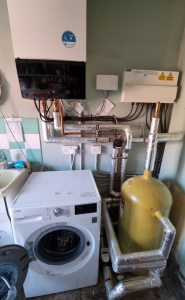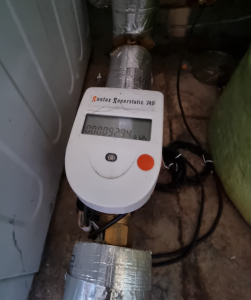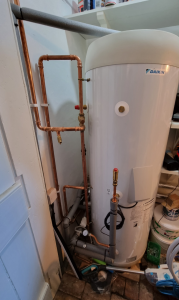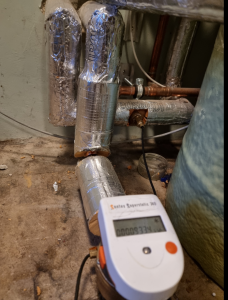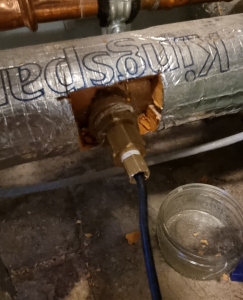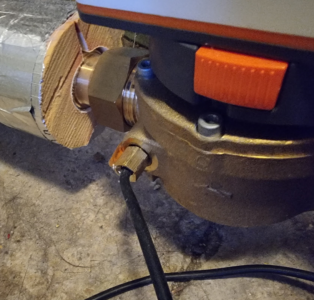Dedicated heat meter and HP heat meter discrepency
Hi all,
I have a Daikin Altherma 3 split, 16kW (EPGA16DV) which was installed back in 2020. Since then, I've been periodically keeping track of the energy usage, that it and the external heat / electricity meters report. I'm seeing a significant discrepancy in the results from the heat meter, and I'm wondering if anyone has seen anything similar or has any suggestions.
The original heat meter was showing around about half the heat produced compared to what the Daikin unit reports. I reported this issue to the installers and after a lot of back and forth, last year they installed a different heat meter. It is closer, but still there is a significant disparity. For example, over the last month the heat meter reports 1458kWh while the Daikin reports 2065kWh (diff compared to last month's readings). The electricity meters are much closer showing 839kWh (EM1) to 805kWh (Daikin). Which reading is used, significantly impacts SCoP: 1.74 if using the external meters and 2.57 if using the Daikin readings.
An SCoP of 2.57 seems low, but it was cold at the start of the month. 1.74 however seems terrible.
I don't know what to do now. I've asked the installers many times, but they just say that the flow calculations show it operating at 400%. That is not reflected in the SCoP at all.
Any ideas, thoughts, suggestions welcome!
Allan
Posted by: @theallanHi all,
I have a Daikin Altherma 3 split, 16kW (EPGA16DV) which was installed back in 2020. Since then, I've been periodically keeping track of the energy usage, that it and the external heat / electricity meters report. I'm seeing a significant discrepancy in the results from the heat meter, and I'm wondering if anyone has seen anything similar or has any suggestions.
The original heat meter was showing around about half the heat produced compared to what the Daikin unit reports. I reported this issue to the installers and after a lot of back and forth, last year they installed a different heat meter. It is closer, but still there is a significant disparity. For example, over the last month the heat meter reports 1458kWh while the Daikin reports 2065kWh (diff compared to last month's readings). The electricity meters are much closer showing 839kWh (EM1) to 805kWh (Daikin). Which reading is used, significantly impacts SCoP: 1.74 if using the external meters and 2.57 if using the Daikin readings.
An SCoP of 2.57 seems low, but it was cold at the start of the month. 1.74 however seems terrible.
I don't know what to do now. I've asked the installers many times, but they just say that the flow calculations show it operating at 400%. That is not reflected in the SCoP at all.
Any ideas, thoughts, suggestions welcome!
Allan
If correctly installed, I would expect the external heat meter to be the more accurate. Please provide photo's, both distance and closeup, of your installation.
Absolutely! One shot of the internal part of the split HP + buffer tank, close up of the heat meter, and one of the DHW tank.
I don't have a schematic of the piping, but I can draw one up if it would be useful.
I'd expect the external meters to be more accurate as well, which is what really bothers me about the SCoP.
Thanks,
Allan
Where are the temperature sensors associated with the heat meter, are they in pockets or clipped to the pipework? Are the temperature sensors making good thermal contact and are they and the pipework adequately insulated?
Where are the temperature sensors measuring the LWT and RWT, and flow meter connected to the heat pump controller?
Low COP can be caused by flow and return water mixing within the buffer tank. What are the temperatures on the pipes going in and out of the buffer?
Hi,
Thanks so much for your help and insight with this! Attached are photos showing the layout of the heat meter and close ups of its two temperature sensors in the pipes. They both appear to be firmly embedded and secure.
This morning I took some readings from the heat meter and the equivalent from the Daikin:
- Heat meter:
- Delta temp: 2.56C (leaving water: 40.6C, inlet 38.1C)
- Flow rate: 1.364 m^3/h
- Daikin:
- Delta temp: 3.9C (leaving water: 40.9C, inlet 37.0C) - the Daikin also has a Leaving water PHE which was 41.5C - I think that's the water temp on the heat exchanger plate?
- Flow rate: 1.332 (on screen as 22.2l/min)
- Analogue meters on manifold:
- Delta temp: 3C (flow: 36C, return 33C)
One thing I did find interesting is that while looking at the numbers on the heat meter over night, the delta went negative a number of times. Only about -0.5C, but I hadn't expected that. The largest delta I saw was +4.6C.
Allan
@theallan I'd definitely suggest you draw a schematic to help us understand, the overall layout and where the metering points are. that may start to give some clues why the meter readings are different.
negative DT will happen hen the circulation pump is running but the heat pump is not heating. RWT can be higher than LWT in that situation. that will happen during defrost, or at any point when the heatpump's compressor has shutdown, but its still keeping the circulation pump running, as part of its normal cycle of control.
My octopus signup link https://share.octopus.energy/ebony-deer-230
210m2 house, Samsung 16kw Gen6 ASHP Self installed: Single circulation loop , PWM modulating pump.
My public ASHP stats: https://heatpumpmonitor.org/system/view?id=45
11.9kWp of PV
41kWh of Battery storage (3x Powerwall 2)
2x BEVs
@Dandee - No I hadn't thought of that - the readings above were while calling for space heating. Do you mean to just disable the call for heat and DHW production?
@iancalderbank - Thanks for the negative number explanation. I'll draw a schematic this weekend and upload it.
As the saying goes "a picture is worth a thousand words".
The heat meter temperature sensors are indeed in pockets, and if correctly installed will hopefully be making good thermal contact. Measuring temperature accurately is not as easy as many may think, since the type of sensor used will have a specified accuracy, then the electronics required to convert the sensor output into an actual reading will also have a specified accuracy. Accurate flow measurement is even more difficult to achieve.
If you were to install two identical heat meters on the same system, I am quite confident that they would not give the same reading, but the readings should be within the specified tolerance.
If you look at the data sheet for your heat meter it should give details of the specified accuracy, you could also ask Daikin what the expected accuracy of their measurements should be. If both heat energy output measuring systems are providing reasonably consistent measurements, the percentage difference between the two readings should be reasonably consistent over a period of time.
As I think has already been pointed out, the LWT and RWT readings can reverse when the heat pump performs a defrost cycle.
I suspect that the low SCOP is probably due to the way your system has been configured and is being operated. Do you have any thermostats or TRV's within your system? Are you operating the system in Weather Compensation (WC) mode or fixed LWT? If in WC mode what are the settings?
another thing to check is whether the heat meter is configured for glycol. A glycol mix has less heat energy than pure H20. My heat meter (which is similar to yours) is set to reduce output by (I think) 20% for this. Make sure you're comparing like with like. In fact my ASHP (Mitsubishi but others may be the same) has several sorts of manual adjustments and fudges you can make so it's worth checking this on yours.
-
Daikin Octopus installation update - I saw my first defrost. 😍😂
3 months ago
-
Daikin Error Code 7H05
1 year ago
-
British Gas versus Octopus: Two possible heat pump routes - how to evaluate them?
1 year ago
-
Daikin COP / energy used measurement from MMI
2 years ago
-
Do I need a bigger volumizer: 8kW Daikin Altherma R32 LT split
2 years ago
- 26 Forums
- 2,418 Topics
- 54.8 K Posts
- 292 Online
- 6,098 Members
Join Us!
Worth Watching
Latest Posts
-
RE: Ecodan Pump Issues… Circulation pump turns off when heat pump compressor turns off
not sure how i messed up that reply above, somehow I pl...
By ASHP-BOBBA , 28 seconds ago
-
RE: GSHP WOES! Midland based engineer recommendations?
@ashp-bobba Thanks so much for the info! Very helpful. ...
By johnbroome , 2 minutes ago
-
So I hear the export MPAN that UKPN assigned should be ...
By Batpred , 1 hour ago
-
RE: Recommended home battery inverters + regulatory matters - help requested
From what I read, the Solis has a very long list of err...
By Batpred , 1 hour ago
-
RE: Ideal HP290 14kW ASHP - how to optimise
Roughly this should cost you £250-£300 per peak month a...
By ASHP-BOBBA , 2 hours ago
-
RE: Installer Fitted 9kW Instead of 11kW Heat Pump and Changed MCS Paperwork - What do I do?
@jamespa thank you again. I know using the offset to tr...
By MairiA , 3 hours ago
-
RE: New Daikin 11kW Altherma 3M install - is it working as it should?
@toodles Thank you for your input. As the days have got...
By Synthbuilder , 6 hours ago
-
RE: Advice for a novice on Mitsubishi Ecodan 6kW
Frost Protect/Freeze Stat is an operation mode, where D...
By F1p , 6 hours ago
-
RE: Fan unit Making terrible noise HELP!!
@gutoffowc Oh no, sorry to hear that, are you in the Ke...
By ASHP-BOBBA , 8 hours ago
-

RE: Sunsynk Whole House Backup Issue
@sheriff-fatman - could you please re-post that in the ...
By Transparent , 8 hours ago
-
RE: Running my new Nibe ASHP efficiently
I didn't. I spent a while manually messing around with ...
By jamieheatpumpnew , 10 hours ago
-
RE: I’m glad the cold spell is over!
I comparison with the 65kWh used above yesterday was on...
By Judith , 11 hours ago
-
RE: Octopus Cosy 12 Heat Pump Regret: Incredibly Loud, Poor Heating & Constant Hum - Help!
I should think so, I thought that pretty much universal...
By JamesPa , 11 hours ago
-

RE: Setback savings - fact or fiction?
I'm also inclined to look into how a defrost is actuall...
By cathodeRay , 11 hours ago
-
MLCP (Multi-Layer Composite Pipe) for ASHP
@editor nope. The info you reported was sufficient for ...
By iotum , 22 hours ago
-
RE: Experience - New Build / Complete New Heating System
@vincro I would be surprised if it is much above 5 to 6...
By ASHP-BOBBA , 23 hours ago
-
RE: Post-Traumatic Heat Pump Stress Disorder
Yes bang on and maybe I can illustrate that by way of e...
By iotum , 1 day ago
-

